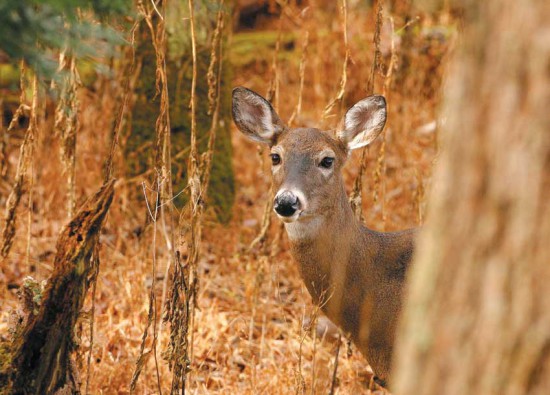Additional tags would all be for antlerless animals
KAGAWONG—It’s not written in stone, but it appears the recommendation coming out of the April 27 deer management consultation meeting held at the Park Centre in Kagawong will be to bump the number of antlerless tags significantly across Wildlife Management Units 43A and 43B by 1,000.
The bulk of the tags, should the minister put his stamp of approval on the recommendation, would be issued for 43B (from Burpee and Mills east). Last year the allocation for that unit was around 3,500, easily dwarfing the less densely populated (by deer) 43A’s 250 tags.
“It went alright,” admitted Little Current Fish and Game Club member Doug Hore of Honora Bay, who attended on behalf of the club. “We wanted an increase in tags and that’s what we got.” Mr. Hore noted that the Ministry of Natural Resources and Forestry representatives appeared to be in favour of the increase as well.
Attendance at the deer management meeting this year was somewhat truncated compared to years past, as the ministry had requested that each local fish and game club stakeholder limit their numbers to two representatives.
Recent deer management suggestions from a few enthusiastic deer hunters calling for a pilot program ending party hunting on the Island (later withdrawn) and controls on baiting did not find as receptive an ear, however, and local farmer representatives were adamant that the damage being caused to their crops has proven to be extensive.
“I can understand that,” said Mr. Hore. “A lot of those guys spend a lot of time, effort and money and then don’t even wind up getting an antlerless tag.”
While farmers can obtain permits to cull animals causing damage to their crops, the process is both long and complicated and requires proof of the damage being caused, too often the damage is done long before the permit is obtained.
“For all of the people who missed the deer management meeting tonight, I would like to say I haven’t had this much fun since I was 15 at a Spring Bay dance,” said Green Bay farmer Paul Skippen, admitting he was somewhat tongue in cheek when discussion with one hunter nearly came to blows. “It started off with a guy offering to take me outside to settle the deer management problem,” he said. “My reply was that if he thought it would solve the overpopulation of deer on the Bidwell I would oblige him.”
“Mr. Selinger (MNR supervisor) did his best to explain why we are inundated with too many deer,” admitted Mr. Skippen, “he gave example of how we might solve the problem.” But the solution of obtaining a permit to cull the animals did not sit well with a number of farmers who describe the process as “all but impossible for an ordinary farmer to get.”
The scale of the problem for farmers is not light, insisted Mr. Skippen. “I counted 65 deer from my place to Roy Bayer’s place, and I understand from talking to some other people that the situation is the same down by Spring Bay.”
Mr. Skippen said that it was time that the province “pay the farmers for their losses. It is not the farmer’s responsibility to control the deer population. MNR takes responsibility for management not landowners.”
“People say ‘it’s only grass’ (referring to hay crops), well if I have to buy my hay from others it’s $25 a bale, and that’s if you can get high quality hay. These animals are eating the highest quality,” he said. “Never has there been this many deer. These guys don’t seem to be doing too good a job managing the deer here on the Bidwell.”
As for the fish and game clubs, Mr. Hore said that they were fairly happy with the outcome of the April 27 meeting. “We didn’t get everything we wanted at one go (referring to a solution to the issue of extensive baiting),” he said, “but it is encouraging.”
The baiting issue is “not about cutting up a few apples and spreading them around,” said one attendee. Anecdotal accounts of truckloads of turnips and apples being unloaded on some hunting properties, drawing the deer from neighbouring properties, abound. “I’ve heard stories but I have never seen it myself,” said Mr. Hore.
But of more concern are the recent advent of automatic deer feeding machines that have been making appearances on hunting properties.




